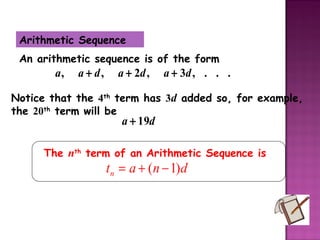
- #Sum of sequence formula plus
- #Sum of sequence formula series
The first week it is one dollar, the second week it is two dollars, the third week it is three dollars and so on. How many cans are needed to make a triangular arrangement of cans if the bottom row has 35 cans and successive row has one less can than the row below it?.
Find the sum of the first 200 terms in \(\ -50+-49+-48+\ldots\)įind the sum of the series bounded by the terms given. Find the sum of the first 32 terms in the series \(\ -70+-65+-60+\ldots\). Find the sum of the first 14 terms in the series \(\ 3+12+21+\ldots\). Find the sum of the first 25 terms of the series \(\ 215+200+185+\ldots\). We could use the calculator in this problem as well: sum( seq(12−3x,x,1,8))=−12įind the sums of the following arithmetic series. Thankfully, you can convert an iterative formula to an explicit formula for arithmetic sequences. In the explicit formula "d(n-1)" means "the common difference times (n-1), where n is the integer ID of term's location in the sequence." In the iterative formula, "a(n-1)" means "the value of the (n-1)th term in the sequence", this is not "a times (n-1)." Even though they both find the same thing, they each work differently-they're NOT the same form. A + B(n-1) is the standard form because it gives us two useful pieces of information without needing to manipulate the formula (the starting term A, and the common difference B).Īn explicit formula isn't another name for an iterative formula. M + Bn and A + B(n-1) are both equivalent explicit formulas for arithmetic sequences. So the equation becomes y=1x^2+0x+1, or y=x^2+1ītw you can check (4,17) to make sure it's right Substitute a and b into 2=a+b+c: 2=1+0+c, c=1 Then subtract the 2 equations just produced: Solve this using any method, but i'll use elimination: I just want an explicit formula for figuring out a sum for a quadratic sequence. The function is y=ax^2+bx+c, so plug in each point to solve for a, b, and c. I tried Googling 'formula for sum of quadratic sequence', which did not give me anything useful. Let x=the position of the term in the sequence One is used to find the sum of the first n terms of a geometric sequence whereas the other is used to find the sum of an infinite geometric sequence. Since the sequence is quadratic, you only need 3 terms. The geometric sum formula is defined as the formula to calculate the sum of all the terms in the geometric sequence. For example, the formula SUMIF(B2:B5, John, C2:C5). that means the sequence is quadratic/power of 2. Definition Formula Harmonic Progression Sum Relation Between AP, GP and HP Examples What is Harmonic Progression A Harmonic Progression (HP) is defined as a sequence of real numbers which is determined by taking the reciprocals of the arithmetic progression that does not contain 0. If you want, you can apply the criteria to one range and sum the corresponding values in a different range. the first term plus one fewer lots of d than the term number. Using the method above, we can see that for a sequence with first term a and difference d, the n th term is always a + (n 1) × d, i.e. The sum of the arithmetic sequence formula is used to calculate the sum of all the terms present in an arithmetic sequence. To find the last number in the series, which we need for the sum formula, we have to develop a formula for the series. An arithmetic progression is one of the common examples of sequence and series.

An itemized collection of elements in which repetitions of any sort are allowed is known as a sequence, whereas a series is the sum of all elements.

However, you might notice that the differences of the differences between the numbers are equal (5-3=2, 7-5=2). Using our previous formula we therefore have the sum of the first 20 terms 1/2 × 20 × (11 + 106) 1170. Math Article Sequence And Series Sequence And Series Sequence and series are the basic topics in Arithmetic.

This isn't an arithmetic ("linear") sequence because the differences between the numbers are different (5-2=3, 10-5=5, 17-10=7) Calculation for the n th n^\text=17 = 5 + 4 ⋅ 3 = 1 7 equals, start color #0d923f, 5, end color #0d923f, plus, 4, dot, start color #ed5fa6, 3, end color #ed5fa6, equals, 17







 0 kommentar(er)
0 kommentar(er)
